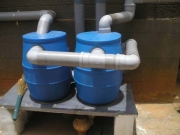/topics/contamination-pollution-and-quality
Contamination, Pollution and Quality
Integrated approaches for sustainable development in water resources sector
Posted on 04 Sep, 2009 12:11 PMThe Indian Institute of Technology, Madras, Technology for Sustainable Development and the Ecole Polytechnique Federale de Lausanne EPFL have produced a report titled Integrated Approaches for Sustainable Development in Water Resources Sector.
Water Quality Issues in India
Posted on 04 Sep, 2009 11:09 AMA presentation titled Water Quality Issues in India by Dr. R C Trivedi of Central Pollution Control Board gives a comprehensive understanding of issues related to water quality. This includes the reasons responsible for degradation in water quality, to the coverage area of the national water quality programme.
Maps on water quality
Posted on 04 Sep, 2009 11:07 AMThe Environmental Information Centre & Maharashtra Pollution Control Board has prepared water quality monitoring maps that, at a glance, reflects the various water sources and their locations.
Water filters used in a rainwater harvesting system - A presentation by Arghyam
Posted on 04 Sep, 2009 10:38 AM This presentation by Arghyam deals with filters used in a rainwater harvesting system as also in other sources to remove suspended pollutants from rainwater collected. In a rainwater harvesting system, the water comes in contact with several surfaces, such as the roof or gutters. Water sources too are contaminated by various minerals and chemicals. These affect the colour, odour, taste and composition of water.Its flow becomes possibly mixed with leaves or dust.
This presentation by Arghyam deals with filters used in a rainwater harvesting system as also in other sources to remove suspended pollutants from rainwater collected. In a rainwater harvesting system, the water comes in contact with several surfaces, such as the roof or gutters. Water sources too are contaminated by various minerals and chemicals. These affect the colour, odour, taste and composition of water.Its flow becomes possibly mixed with leaves or dust.
A training module on water quality monitoring and surveillance
Posted on 01 Sep, 2009 10:49 AMThe monitoring of water quality at the community/cluster or district level involves key processes including survey, processing of data, and implementing remedial and preventive action.
Arsenic contamination of irrigation water, soil and crops in Bangladesh: A paper from the UN Food and Agriculture Organisation
Posted on 29 Aug, 2009 12:53 PMArsenic contamination of irrigation water, soil and crops in Bangladesh: Risk implications for sustainable agriculture and food safety in Asia.
Remediation of arsenic for agriculture sustainability, food security and health in Bangladesh
Posted on 29 Aug, 2009 11:44 AMArsenic (As) in groundwater is a major health concern in Asia and the risks from using shallow tube wells (STWs) for drinking-water are well- known. At present, twelve countries in the Asian region have reported high As levels in part of their groundwater resources.
Groundwater Foundation: Benefits of being a groundwater guardian community
Posted on 26 Aug, 2009 02:28 PMHow can citizens or NGOs initiate a movement at the local level for the protection of groundwater?
Groundwater Foundation is a non-profit organization dedicated to educating and motivating people to care for and about groundwater.
Critical issues related to groundwater: Centre for Water Policy
Posted on 26 Aug, 2009 02:16 PMClick on the link below for a comprehensive understanding about the issues related to groundwater.
Click on to know more about critical issues on groundwater in India
Maps depicting the arsenic contamination in the Ganga-Meghna-Brahmaputra plains between 1976 and 2008
Posted on 20 Aug, 2009 06:11 PMThe School of Environmental Studies - Jadavpur University (SOES-JU), has done path-breaking research in reporting and documenting the issue of Arsenic contamination in the country.





